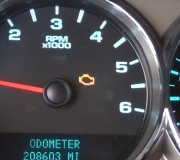Most of the parts you replaced won't cause the symptoms you listed. This sounds typical of a vacuum leak or an exhaust leak.
A leaking vacuum hose or intake manifold gasket will allow extra air in. The oxygen sensor in the exhaust system will see that air and tell the engine computer to hold the injectors open longer to match that air with extra fuel. Engine speed will go up, but the oxygen sensor will still be seeing the extra unburned oxygen.
O2 sensors do not measure exta fuel, only unburned oxygen. The computer will kep dumping in extra fuel, but it will never be enough. When the engine is still cold, use a squirt bottle to spray water on the intake gasket and vacuum hoses while the engine is running. When you find the leak, the water will get sucked in harmlessly and the engine will slow down.
An exhaust leak will cause a similar problem. Between each pulse of exhaust flow, momentum causes a pulse of vacuum. If the leak is before the O2 sensor, air can be drawn in through the leak. The air again will be detected by the O2 sensor, and the computer will command an increase in fuel. Usually this just kills fuel mileage and doesn't affect idle speed.
The MAP sensor measures load on the engine. This sensor has the greatest affect on fuel delivery, but they usually fail over a period of minutes or hours, not days or weeks. Upon total failure, the engine computer will memorize a diagnostic fault code, turn on the Check Engine light, and it will disregard the sensor's reading. The computer will run the engine as well as possible with the missing sensor. Neither performance nor fuel mileage will be good, but you might be able to drive to the repair shop. Often the engine will stall unless you are physically moving the gas pedal up or down. It should not cause a high idle such as you described.
The throttle position sensor is only used to verify the MAP sensor's call for more fuel due to increased load on the engine. The computer also watches its readings to determine direction and rate of movement of the gas pedal. The will be some surging, or "hunting" of idle speed, but a defective TPS won't cause excessively high idle.
Caradiodoc
SPONSORED LINKS
Tuesday, February 9th, 2010 AT 6:22 PM





